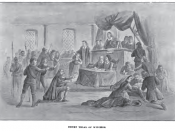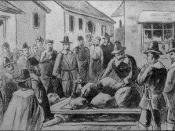What were the reasons for such a large number of witch trails in the 17th century?
Witchcraft has been a fascination through out the centuries. In the 17 century Witchcraft grew from superstition. Witchcraft became the common name for anything unexplained, so anything at all out of place or out of the ordinary was at risk, this is probably one of the contributing factors for such a large number of confessions. This essay shows how and why witchcraft was treated and then looks more deeply into its roots and background. It looks at issues like, why after the civil war did witchcraft become such a big thing. To do this growth of the press, village life, and religious change leading to an increasingly suspicious society are all valid points to consider.
England in the 17th century had a fragile social state, with most sorts of class systems abolished or just lost due to the civil war, making communities vulnerable to wild allegations.
As a time of change was underway, when things didn't quite go the way they were wanted, with such a great lack in scientific knowledge, the only way to understand things was by looking to the paranormal. The society of the time was mainly Puritan, so the church would have played a strong role in village life. The day would be centred around church, where much time would be spent listening to the preaching's. The Puritans believed that the Devil had the same strong presents as God. Witches were said to be the arms of the devil. They were believed to have contracts with the devil so in turn had sold their souls to the devil, in return they would get power.
Matthew Hopkins was the most successful and well known witch catcher in England in the 17th...



Magnificent!
Wow--- I can't believe how pinpointing and historically correct this article is --- I would recomend this to anyone writing an essay on the Salem Witch Trials and their dramatic effects!-- by Crazy Blue Chic
7 out of 8 people found this comment useful.